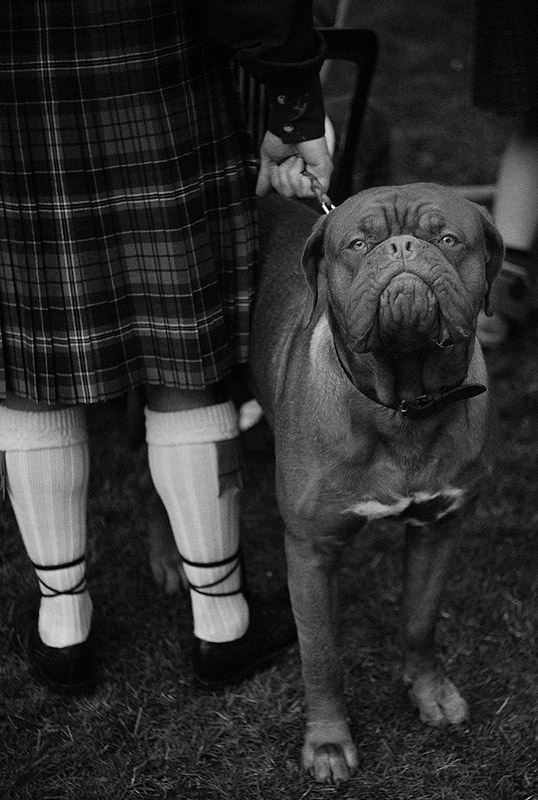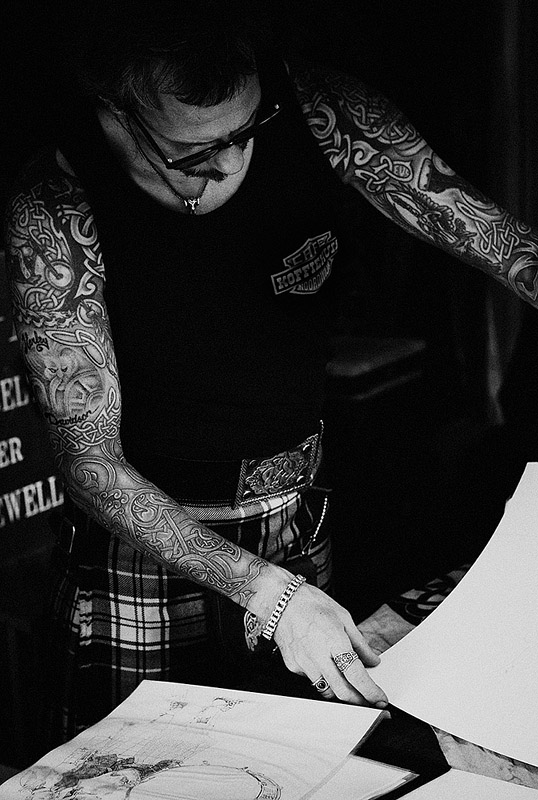biggambi
Vivere!
I would like to get some idea of how digital has changed how people think about ISO. I have grown up on film, and I have added digital a while ago. There is so much talk about noise at high speeds, but I just don't see the issue. I am use to grain, and sensor noise is just a part of life with a digital system. Just as grain is part of life with film.
Specifically, it seems that the speed and quality of Leica M lenses have been built around film speeds that are well covered by the new leica M9. I think that the workable ISO range, the lenses offered, and the full frame sensor make for a very nice digital system. How do you perceive this combination?
What I am wondering with regard to resolution is with either the M8.X or M9: ISO speed and print size. Film vs digital? What have you found to be the point where film exceeds the digital M8/9? I know there are other variables with printers etc. But, let's face it, this is just a friendly inquiry, not a scientific study.
When I think of some of the greatest pictures ever taken, they are so often not technical marvels. Instead they captured a moment in a unique and emotional manner. Or, they are of a wonderful moment in nature or human life; and, they evoke either a personal memory or elicit a new emotion. What I don't remember is were they perfect technical pictures. I understand that new standards are something that evolve over time. But, I am wondering what are we really gaining?
Of course I look forward to the day that we hit enough sensor resolution to equal the resolving power of the lenses. This is an optimized system. But, given the technology available today, coupled with the design constraints. The M9 looks to be a wonderful achievement. I look forward to trying one some day.
What say you?
Specifically, it seems that the speed and quality of Leica M lenses have been built around film speeds that are well covered by the new leica M9. I think that the workable ISO range, the lenses offered, and the full frame sensor make for a very nice digital system. How do you perceive this combination?
What I am wondering with regard to resolution is with either the M8.X or M9: ISO speed and print size. Film vs digital? What have you found to be the point where film exceeds the digital M8/9? I know there are other variables with printers etc. But, let's face it, this is just a friendly inquiry, not a scientific study.
When I think of some of the greatest pictures ever taken, they are so often not technical marvels. Instead they captured a moment in a unique and emotional manner. Or, they are of a wonderful moment in nature or human life; and, they evoke either a personal memory or elicit a new emotion. What I don't remember is were they perfect technical pictures. I understand that new standards are something that evolve over time. But, I am wondering what are we really gaining?
Of course I look forward to the day that we hit enough sensor resolution to equal the resolving power of the lenses. This is an optimized system. But, given the technology available today, coupled with the design constraints. The M9 looks to be a wonderful achievement. I look forward to trying one some day.
What say you?
Last edited:
biggambi
Vivere!
I agree that digital noise has no aesthetic appeal. I always switch to black and white mode for images that are displaying this to try and capture what I wanted. I have shot a lot of black and white over the years and Kodachrome 64. I think this skill set has transfered over to the digital realm quite nicely. I have grown to really like the Nik Silver Efex Pro plug in for processing.
Roger Hicks
Veteran
Noise doesn't worry me either: like the OP, I see it exactly the same way as grain, and cheerfully shoot at 2,500 even with the original M8.
Cheers,
R.
Cheers,
R.
xxloverxx
Shoot.
I'd be more willing to shoot film for high ISOs simply because I feel that film grain has texture and "feel" that digital noise doesn't - sometimes, looking at grain, I can almost feel it between my fingers… 
jaapv
RFF Sponsoring Member.
Nor has film - but our eyes have been trained to accept it for more than hundred years.I agree that digital noise has no aesthetic appeal.
J. Borger
Well-known
Film grain is beautiful, so is digital noise .... in B&W at least.
Never use my M8 at iso 160 because i do not like the clean digital look in B&W.
Color is a different story .......
Never use my M8 at iso 160 because i do not like the clean digital look in B&W.
Color is a different story .......
isorgb
Well-known
Film grain is beautiful, so is digital noise .... in B&W at least.
Never use my M8 at iso 160 because i do not like the clean digital look in B&W.
Color is a different story .......
I think that digital camera allow you to choose "after" what do you want... and "grain like high iso" you can do in post-process, even ISO160. I know "looks like", but both pictures are from digital files, not from film.
What do you think?
johannielscom
Snorting silver salts
Slightly OT, on the M8 and M9 metering system: I learned to rate my 200ASA film at 160, my 400ASA at 320. The M8 and M9 meters mock this.
People often complain the M8 meter is off, but it is off for a reason. One-third of a stop overexposed shots have well light-saturated pixels and if you reduce the overexposure when you develop, the grain is reduced as well.
There is a chance you blow out highlights. In general, I think Leica have made a choice that suits them, the M cameras being considered low light cameras for decades.
I agree with J.Borger, noise in B&W resembles grain (although that noise still has a digital look to it), but noise in color often is ugly.
People often complain the M8 meter is off, but it is off for a reason. One-third of a stop overexposed shots have well light-saturated pixels and if you reduce the overexposure when you develop, the grain is reduced as well.
There is a chance you blow out highlights. In general, I think Leica have made a choice that suits them, the M cameras being considered low light cameras for decades.
I agree with J.Borger, noise in B&W resembles grain (although that noise still has a digital look to it), but noise in color often is ugly.
J. Borger
Well-known
Right ... but i prefer to start with a M8 iso 640 raw file and proces (mostly with Alien Skin Exposure) from there ...I think that digital camera allow you to choose "after" what do you want... and "grain like high iso" you can do in post-process, even ISO160. I know "looks like", but both pictures are from digital files, not from film.
What do you think?


Last edited:
isorgb
Well-known
J.Borger, yes, I understand.
I use high ISO for digital BW too. Both pictures are from Epson R-D1 ISO800 (+1EV in post-proces).
(I know, this is Leica M thread, but I showed for example only)


I use high ISO for digital BW too. Both pictures are from Epson R-D1 ISO800 (+1EV in post-proces).
(I know, this is Leica M thread, but I showed for example only)


Last edited:
Tim Gray
Well-known
Nor has film - but our eyes have been trained to accept it for more than hundred years.
I haven't been alive for 100 years...
I get what you are saying though. It's kind of like the way a tube amp distorts compared to how a solid state amp distorts. Much of rock and roll originated one tube amps, so it's ingrained into our idea of how rock should sound.
That being said, there could still be a psychological preference towards distortion from a tube amp (and film grain) as opposed to the newer technology's weak points. In fact, I that actually might be true in the case of audio...
I think the digital noise most people don't like is the large chroma splotching (which is relatively easy to get rid of) and banding, neither of which happen with film to a great extent. At least, I don't like those two types of noise; the random pixel-level noise isn't that offensive. On the other hand, digital has clearly gotten past film in terms of speed without these two types of noise getting out of control.
The other gripe I have with digital pictures is the abrupt manner in which highlights clip.
abumac
Well-known
M8 and 2500 Asa sucks? It works perfectly. Look here. No NR. All fotos with very low light. The last one you can find it here http://mimpresion.blogspot.com/2009/12/aminatu-libertad.html a little bit bigger.






Last edited:
Ted2001
Established
When I was shooting film I used Kodachrome 25 and later Velvia (ASA 50), so the advent of digital with base ISO of 200 represents a whole new world of opportunity for me. I am as satisfied with 12 MPs at ISO 400 (D90) as I was with K25 or Velvia giving me an additional 3-4 stops. When working at 1:1 shooting macro, that additional speed is a gamechanger for me.
Makten
-
I like digital noise, as long as it isn't chroma noise. The M8 gives a beautiful grain at moderate ISO speeds, if you get rid of the chroma in PP or go for B/W. But the problem isn't noise. It's the banding that makes me not shoot over 1250. Banding really looks like crap, and the M8 gives alot of that if you're not carful.
I really wish the M8 wouldn’t band. Then I would fully explore the frontiers of digital noise.
Pickett Wilson
Veteran
"It will be interesting to see if the children who grow up with this type of noise will develop a level of mental filtering. A system that allows them to disregard it on a sub-conscious level. But, we will not get beyond the fact that in the end, "we" are analog by nature. Digital will not ever be a natural part of us."
Technology is making your point mute. It has become trivial to produce high ISO, noiseless images at any common image size these days. Unless you are also arguing that the absence of noise in images is unnatural, which would have nothing to do with nature, but with nostalgia.
And blissfully, as we get older, the decline in functioning of our eyes and ears provide all the filtering necessary to enjoy the "flawed" experiences.
Technology is making your point mute. It has become trivial to produce high ISO, noiseless images at any common image size these days. Unless you are also arguing that the absence of noise in images is unnatural, which would have nothing to do with nature, but with nostalgia.
And blissfully, as we get older, the decline in functioning of our eyes and ears provide all the filtering necessary to enjoy the "flawed" experiences.
Last edited:
biggambi
Vivere!
"It will be interesting to see if the children who grow up with this type of noise will develop a level of mental filtering. A system that allows them to disregard it on a sub-conscious level. But, we will not get beyond the fact that in the end, "we" are analog by nature. Digital will not ever be a natural part of us."
Technology is making your point mute. It has become trivial to produce high ISO, noiseless images at any common image size these days. Unless you are also arguing that the absence of noise in images is unnatural, which would have nothing to do with nature, but with nostalgia.
And blissfully, as we get older, the decline in functioning of our eyes and ears provide all the filtering necessary to enjoy the "flawed" experiences.
I agree that technology will trickle down. Although, at some point, certain thresholds will require some significant breakthroughs. But, I do believe we have already seen this effect to some degree.
There has been a rather steady progression to low resolution listening and viewing in our culture. I agree that image technology will overcome this issue within a reasonable length of time. But, the constant want for smaller, more portable items has meant most people do not consider these artifacts to be a serious problem. It is more a problem for the critical observer. I will give the following three examples to support this view.
1. The quality of an mp3 recording is dismal compared to the master copy. There are higher quality audio recordings, but people choose the convenience of the other.
2. I would contend that more images are shared among people via their camera phones than high quality cameras. Younger people have already accepted this degradation, for the choice of convenience.
3. More people view photos on a computer and "digital frames." Then people purchase well made prints.
All three of these things have become a part of our culture, and eagerly embraced by most people. So, yes upon thinking through this point. My point is not very good. Because, it has not required any time at all. People all ready think crap is great.
Thank God I am getting older. When do the eyes go?
not_in_good_order
Well-known
Digital luminescence noise is not objectionable to me unless there is banding present. Chroma noise is ugly, but is absolutely simple to remove with little to no impact on image quality.
MCTuomey
Veteran
j borger, abumac, and isorgb: great samples of high ISO files. fact is that they'd look even better in print (noise looks worse on monitors), i'd bet.
j borg and abumac, a question: which raw converter are you all using? converting to 8 bit tiffs with minimal to no adjustments? allowing any default chroma noise removal?
j borg and abumac, a question: which raw converter are you all using? converting to 8 bit tiffs with minimal to no adjustments? allowing any default chroma noise removal?
J. Borger
Well-known
j borg and abumac, a question: which raw converter are you all using? converting to 8 bit tiffs with minimal to no adjustments? allowing any default chroma noise removal?
Capture one. No noise reduction .
Further processing with CS3, often using Alien Skin exposure for B&W.
Alternatively i use B&W profiles from JFI Colorlabs in Capture one and proces directly to B&W.
Share:
-
This site uses cookies to help personalise content, tailor your experience and to keep you logged in if you register.
By continuing to use this site, you are consenting to our use of cookies.
